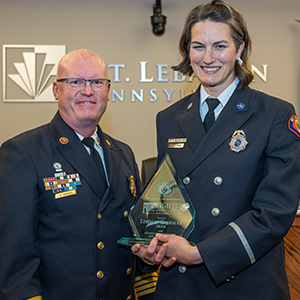Police
 CHIEF
CHIEF
Aaron Lauth
412-343-4016
alauth@mtlebanon.org
555 Washington Rd Pittsburgh, PA 15228
Website: www.mtlebanonpd.org
The Mt. Lebanon Police Department has 46 sworn officers. Headed by Police Chief Aaron Lauth, the department has a patrol division consisting of 32 officers and one canine, and also has investigative services, traffic services and community outreach units. Last year the department handled a total of 20,819 calls, including 3,392 traffic stops.
CALL 911 whenever you need to see or speak with a police officer, even if it is a non-emergency situation. The call taker will record your information and an officer will be dispatched to your location or contacted to return your call.
Overnight Parking
On-street parking is prohibited in Mt. Lebanon between 2 and 6 a.m.
If you have a special circumstance, such as an overnight guest, construction or repaving of your driveway, you can request special permission for overnight parking by calling 412-343-4023 between the hours of 6 and 11 p.m., prior to parking the vehicle overnight, or make a request through mylebo.mtlebanon.org. Click the Overnight Parking Request link on the home page.
Parking Tickets
Mt. Lebanon recently made it easier to pay or appeal parking tickets of any type. The new system is more efficient and gives residents better access to due process.
If you wish to appeal the ticket, go online at mylebo.mtlebanon.org, or call 412-343-3705. If you lose your appeal, you do have further recourse. See the diagram, below left.
For general questions related to parking enforcement, call the Mt. Lebanon Parking Enforcement Supervisor, Mark Quealy at 412-440-2035.
Fingerprinting
Fingerprinting for job applications is done on Tuesdays, from 8:30 to 10 a.m., by appointment only. The cost for a resident is $20 for the first card and $5 for each additional card. The cost for a non-resident is $25 for each card. Proof of residency is required. To schedule an appointment, call 412-343-4095, weekdays between 7:30 a.m. and 3:30 p.m.
Megan’s Law
Those who are required to register as a sex offender must do so through the Pennsylvania State Police. View the Megan’s Law registry of sex offenders.
Police Reports
If you need a copy of a police report, you can request it at the police department records desk, on the third floor of the Mt. Lebanon Public Safety Building. There is a $15 cost for most reports. A subpoena is required for reports where an arrest has been made. Under no circumstances will a juvenile’s information be released.
Vacation Cards
You can come to the police department records desk, third floor of the Public Safety Building, and request a vacation card, which will let police officers know you will be away and list emergency contacts for your residence.
Child Safety Seats
An officer can inspect and teach you how to properly install your child seat. For information or to set up an appointment, please call 412-343-4068.
Tours
If you belong to a group and would like a tour of the Police Department and Public Safety Building, you can call the Crime Prevention Unit, 412-343-4068, to schedule the tour. Tours last about 40 minutes. You can also arrange for a tour with the fire department to coincide with the police department tour.

Animal Control
South Hills Cooperative Animal Control (SHCAC) employs six full-time officers, all certified by the National Animal Care and Control Association. They have the authority to write citations, file animal bite reports, quarantine animals that are at risk for having rabies and euthanize animals. The officers are Mt. Lebanon Police Department employees, with an office in the Public Safety Center and a kennel at the Upper St. Clair Municipal Building.
The officers respond to calls for wild animals, stray and lost pets, animal-related ordinance violations (such as barking or roaming dogs) and humane animal concerns in Mt. Lebanon, Upper St. Clair, Dormont, Scott, Green Tree, Whitehall, Castle Shannon, Carnegie, Baldwin Township, Bethel Park, Heidelberg, Rosslyn Farms and, just this year, the service expanded to Baldwin Borough.
If you have an animal issue, call 911 or the non-emergency number, 412-279-6911. The same call-takers answer both lines and take messages after normal business hours, which are 7 a.m. to 9 p.m. weekdays and 7 to 5 on weekends. If your after-hours call is urgent, dispatchers will send police.
By far, the most common call is for wild animals. Officers will try to get the animals out of your house if they’re in living areas, but they can’t go into attics or up on a ladder. A wild animal call will most likely result in setting some kind of a trap, such as a box trap. Animal Control will lend you the trap, which comes with instructions, and ask you to call them if you catch anything.
One animal that SHCAC can’t touch is a skunk. Skunk spray can permeate the inside of a truck and put the vehicle out of commission. Animal Control will refer you to a private wildlife removal service for that.
There are a few things, in addition to checking your yard before letting pets out, that you can do to avoid a wild animal invasion. The main thing: Keep food off the ground.
If you have inside-outside pets, only feed them inside. Food bowls on the patio are bound to attract animals. If you have bird feeders, be sure to clean up any food that spills onto the ground. Even pet waste can be a food source. And please don’t feed the deer. Mt. Lebanon has an ordinance against it. Bringing more deer into your yard increases the chance of disease transmission, and decreases the deer’s healthy fear of humans.
The ground underneath sheds, decks and other structures are prime spots for burrowing animals. Rats can nest in brush and compost piles, and can burrow into wood piles that are on the ground. Storing wood in a box or other container off the ground prevents animals from taking shelter there.
Rats can enter your house through holes in wood, brick, pipe—even the venting for your dryer. Once inside, they’ll roam around, chew through wood cabinets and help themselves to food in cardboard containers. Store grain products in glass or metal containers.
Animal Control has a homegrown recipe for ridding yourself of unwanted occupants living under the deck or in the attic: Mix a cup of ground cayenne pepper with three to five whole habanero peppers in water and spray it around the entrance. Be careful using this inside, because it could have the same effect on you as it does on the animal. Reapply after a rainstorm.
Just seeing a wild animal is not necessarily cause for alarm. Unless the animal is a nuisance, damaging property or putting pets or people at risk, the advice is: Coexist. But even if there is nothing Animal Control can do, it’s still worth a call.
Animal Control officers will tell you the best part of their job is reuniting pets with owners. The kennel at Upper St. Clair has been in operation since 1978. Call Animal Control if your pet is missing.
Check the animal control section of the police department website, www.mtlebanonpd.org for photos and descriptions of animals housed at the kennel to see if yours is there. Animal Control doesn’t like to broadcast too many details about the animals they pick up, because there are people who will claim them even though they aren’t theirs.
If you would like SHCAC to post a missing pet poster, email the details, the name of the pet, the last known location of the pet, and a picture to shcac@mtlebanon.org.
Shorten the time you’re away from a lost pet by chipping them—and remember to keep your chip registration information up to date.
 Look Up Lebo
Look Up Lebo
Mt. Lebanon is a walking community of 33,000 people, in a town that sees upwards of 60,000 vehicles a day passing through. So everyone—drivers, pedestrians and cyclists—has to coexist. And that’s not always easy.
In 2016, Mt. Lebanon launched a campaign called Look Up Lebo. The campaign is based on three fundamental components of traffic safety: engineering (enhancing the physical safety of the streets), education (reminding people of safe practices) and enforcement (making sure people follow the rules).
While pedestrians—once they enter a crosswalk—usually have the right of way, the Pennsylvania Vehicle Code also requires pedestrians to ensure conditions are safe before attempting to cross a street. Don’t assume the cars will stop. Stay on the curb until the vehicles in the roadway yield and you can cross safely.
Of course, there are distracted pedestrians as well—people who are late for an appointment, talking or texting on their phones, wearing headsets, gabbing with their friends or trying to manage their dogs. And cyclists who, if not distracted themselves, become distractions when they ignore the fact that the rules of the road apply to them and their vehicles, as well as to cars.
Safety Tips for All of Us
Walk facing oncoming traffic, if a street has no sidewalk. If a street has a sidewalk, you are required to use it, even if it’s on the other side of the street from you. Follow all traffic signs, signals and markings, even if it means you have to wait your turn. Pay attention to others around you, and not your phone.
Try to make eye contact with drivers, so you know they know you’re there.
Don’t cross where the driver’s sight may be restricted, such as behind a parked car or an overgrown hedge. Make sure both sides of the road are clear, and there is no one passing parked or standing cars in the opposite lane.
Follow the same traffic laws as drivers when you’re riding a bike. No cruising through stop signs or red lights. Yield the right of way to pedestrians, and give them some warning prior to overtaking and passing them. Bikes must have lights from dusk to dawn. And remember, cyclists can be arrested for DUI.
Ride your bike on the street in the business districts. It’s against the law to ride on the sidewalks there.
Share the lane when you are cycling more slowly than motor vehicle traffic. Move as far right as you safely can. Always ride in the same direction as traffic.
Drivers should steer clear of bikes and give them at least four feet of clearance.
Be alert to the door zone, the three to four feet of space next to parked vehicles where someone can open a door into your path. Also, be extra careful at intersections, as some drivers may not always signal when they are making a turn.
Ride or drive at or below the posted speed limit. This gives you time to react to other vehicles, pedestrians, deer or other sudden movers.
Keep your eyes on the road and your thumbs on the wheel.
Move to the curb lane and stop when an emergency vehicle approaches. Slow down when you pass an emergency vehicle that is stopped on the side of the road.
Get enough sleep. A tired driver is a distracted driver.
Set your GPS and turn up the volume before you hit the road.
And remember the old adage, Stop, Look and Listen before you cross the street!





